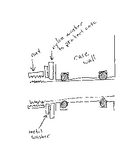lucca brassi
Contributor
Between washers I would not put any rings because they don't seal enough.
I would apply rich all gaps between washers with SIKAFLEX SEAL KIT and tight washers and nuts tight .
SIKAFLEX work in that way that between curing expand and squeeze all the air from the gap basicaly it made 3D seal .
Sikaflex 291i Marine Adhesive & Sealant 300ml
---------------------------------------------------------------------------
threads in plastic housing are not best idea (depends on material and thickness ) because so called ''notch effect'' what basicaly means'' demolish the structure of the material''
I would apply rich all gaps between washers with SIKAFLEX SEAL KIT and tight washers and nuts tight .
SIKAFLEX work in that way that between curing expand and squeeze all the air from the gap basicaly it made 3D seal .
Sikaflex 291i Marine Adhesive & Sealant 300ml
---------------------------------------------------------------------------
threads in plastic housing are not best idea (depends on material and thickness ) because so called ''notch effect'' what basicaly means'' demolish the structure of the material''
[h=1]notch effect[/h]noun
1.(metallurgy, building trades) the increase in stress in an area of a component near a crack, depression, etc, or a change in section, such as a sharp angle: can be enough to cause failure of the component although the calculated average stress may be quite safe






